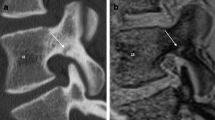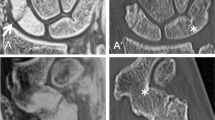Abstract.
The aim of this study was to compare the performance of CT and MRI in the diagnosis of longitudinal stress fracture of the tibia (LSFT). A retrospective study of imaging findings was performed in 15 patients with LSFT. The CT and MR images were compared for detection of fracture line, callus, bone marrow edema, and soft tissues changes. The CT and MRI techniques allowed the detection of the fracture line in 82 and 73 % of cases, respectively. The callus was always visualized with CT or MRI. The MRI technique had a markedly higher sensitivity than CT in the detection of bone marrow edema (73 vs 18 %) and soft tissue lesions (87 vs 9 %). This may cause a misleading aggressive appearance on MRI. Computed tomography remains the best imaging modality for diagnosis of LSFT. However, MRI findings should be known to obviate the performance of CT or bone biopsy.
Similar content being viewed by others
Author information
Authors and Affiliations
Additional information
Received 26 May 1997; Revision received 1 October 1997; Accepted 13 November 1997
Rights and permissions
About this article
Cite this article
Feydy, A., Drapé, JL., Beret, E. et al. Longitudinal stress fractures of the tibia: comparative study of CT and MR imaging. Eur Radiol 8, 598–602 (1998). https://doi.org/10.1007/s003300050442
Issue Date:
DOI: https://doi.org/10.1007/s003300050442




